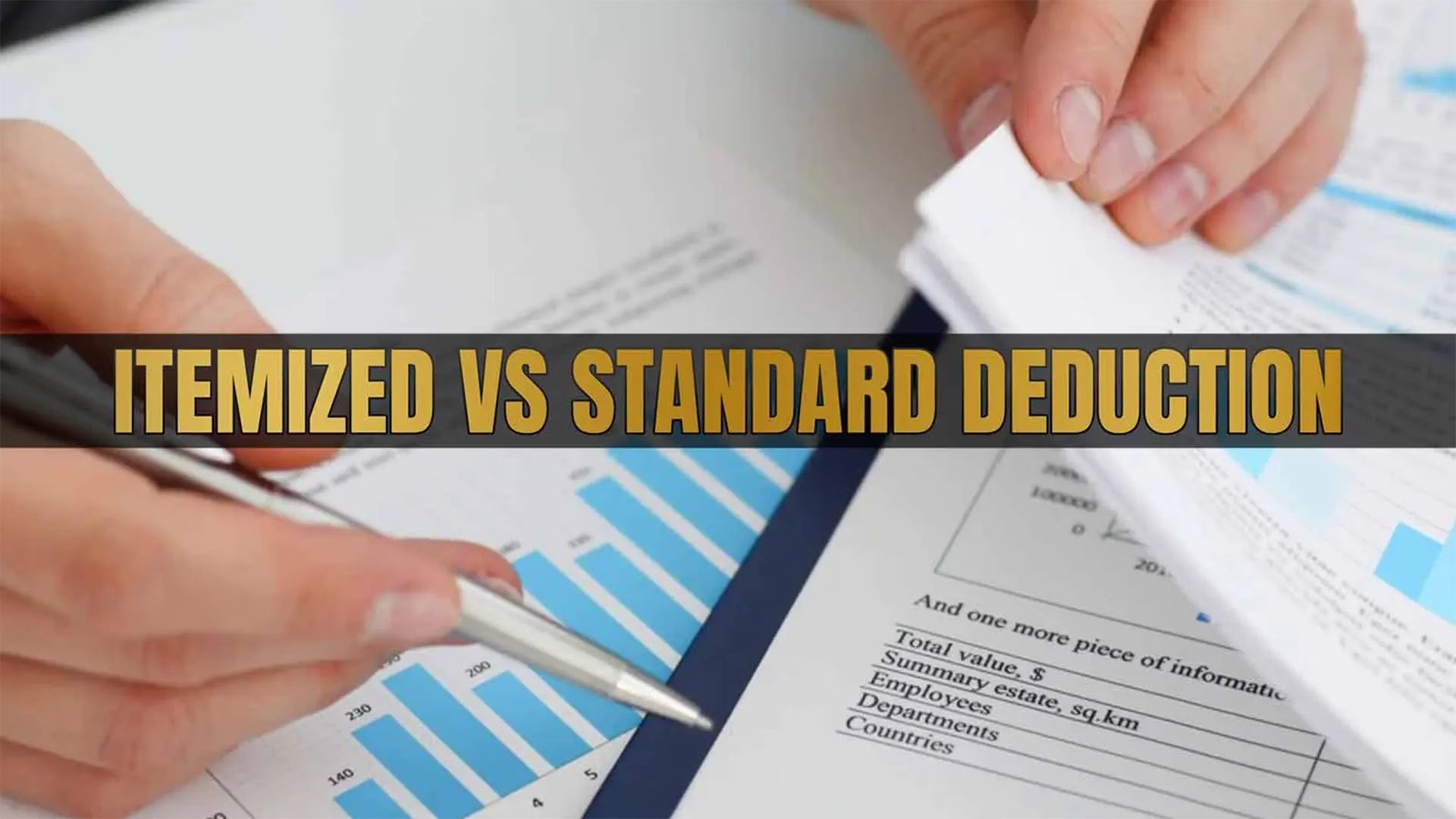
Slash Your Tax Bill by Understanding What the IRS Allows You to Deduct
What Are Individual Tax Deductions and Why Do They Matter?
Every dollar you deduct from your income is a dollar the IRS can’t tax. Tax deductions reduce your taxable income, which can lower your tax bracket, reduce your final tax bill, and in many cases, increase your refund.
Tax deductions fall into two categories:
- Standard deduction: A fixed amount set annually by the IRS.
- Itemized deductions: A detailed list of eligible expenses that you subtract from your income.
For 2025, the standard deduction estimates are:
- Single: $14,000
- Married filing jointly: $28,000
- Head of household: $20,800
You can only take either the standard deduction or itemized deductions, not both. This guide breaks down all major itemized deductions and other tax-reducing strategies available to individuals in 2025.
Section 1: Medical and Dental Expense Deductions
Quick Rule:
You can deduct unreimbursed medical expenses above 7.5% of your Adjusted Gross Income (AGI).
Example:
If your AGI is $80,000, only the portion of your qualified expenses exceeding $6,000 is deductible.
Eligible Medical Expenses
- Doctor visits, surgery, and hospital stays
- Prescription drugs, insulin, and prescribed medical devices
- Dental care, including cleanings, dentures, and surgery (except cosmetic procedures)
- Vision care, including eye exams, eyeglasses, and corrective surgery (e.g., LASIK)
- Health insurance premiums (if paid out of pocket and not through pre-tax payroll deductions)
- Nursing home care (when needed for medical reasons)
- Mental health counseling and psychiatric services
- Medical-related travel (gas, tolls, parking, lodging up to $50/night per person)
- Home modifications for medical needs (e.g., wheelchair ramps)

Other, More Specific Eligible Medical Expenses
- Abortion
- Acupuncture
- Alcoholism treatment at an inpatient facility or transportation costs to and from doctor-recommended Alcoholics Anonymous meetings.
- Ambulance Rides
- Angiotensin Converting Enzyme (ACE) Inhibitors
- Bandages or similar medical supplies
- Birth Control Medication
- Blood Pressure Monitor
- Body Scans
- Braille Reading Materials. The cost difference between Braille and non-Braille books is deductible
- Breast Pumps
- Breast Reconstruction Surgery following a Mastectomy
- Chiropractor Visits
- Christian Science Practitioner Visits
- Contact Lenses
- Crutches
- Diabetic Supplies
- Diagnostic Services
- Disabled Dependent Care.
- Drug Addiction Treatment at an inpatient facility
- Face Masks
- Fertility Procedures or Surgeries
- Founder’s Fees are used to prepay medical treatment in a nursing home
- Glucometer
- Guide Dogs, including any expenses to feed and care for them
- Hand Sanitizer
- Hearing Aids, including repair and maintenance
- Hearing-Impaired Telephone and/or Television equipment and repairs
- Hospital Stays
- Internal Normalized Ration (INR) testing
- Insulin and other glucose-lowering agents
- Laboratory Fees
- Lead-Based paint removal for the benefit of a child with lead poisoning
- Legal Fees to authorize mental illness treatments
- Meals during any stay at a medical facility
- Medical Conferences
- Nursing Services
- Organ Donation
- Osteopathic Care
- Pregnancy Tests
- Prosthetic Limbs
- Psychiatric Care
- Psychological Visits
- Reconstructive Surgery
- Selective Serotonin Reuptake Inhibitors (SSRIs)
- Special Education Schooling or Tutoring that is recommended by a doctor
- Stop-Smoking Programs (except over-the-counter)
- Transportation that is necessary for medical care, including vehicle modification costs
- Weight-loss programs are prescribed by a doctor. Food expenses are not generally included
- Wigs recommended by a doctor
- Wipes (for Virus prevention)
- X-Rays
IRS Form:
Use Schedule A to report these deductions.
Not Deductible:
- Cosmetic procedures are not medically necessary
- Over-the-counter medications (unless prescribed)
- General wellness or gym memberships
Section 2: Homeownership and Property-Related Deductions
Owning a home opens up several tax-saving opportunities. If you itemize, these can add up fast.
Deductible Housing-Related Expenses:
- Mortgage interest(limited to interest on up to $750,000 of mortgage debt)
- Mortgage points(prepaid interest, spread out over the loan’s term)
- Private mortgage insurance (PMI)for loans originated after 2007 (subject to income limits)
- Late payment penalties and early payoff fees
- Property taxes(subject to the $10,000 SALT cap, explained below)
- Cooperative apartment interest (your share of the building’s mortgage)
- Ground rent (must be redeemable under state law)
Example: If you paid $10,000 in mortgage interest and $7,000 in property tax, you can potentially deduct $17,000—if you itemize.

Section 3: Education-Related Tax Deductions
Whether you’re paying for your own education or helping a dependent, the IRS offers several ways to lower your tax bill through education deductions and credits. While this section focuses on deductions, we’ll briefly note important credits as well.
Deductible Education Expenses
- Tuition and Fees Deduction (above-the-line deduction)
- You may deduct up to $4,000 in qualified tuition and fees paid to an eligible post-secondary institution.
- You don’t need to itemize to take this deduction.
Qualified expenses include:
- Tuition
- Enrollment fees
- Required course materials (sometimes)
Not included:
- Room and board
- Transportation
- Optional fees (like athletic or student activity fees)
IRS Form: Claimed on Form 8917 if available (subject to renewal by Congress each year)
- Student Loan Interest Deduction
- You can deduct up to $2,500 in interest paid on qualified student loans.
- This deduction phases out based on Modified AGI:
- Single filers: phaseout begins at ~$75,000
- Married filing jointly: ~$150,000
To qualify:
- The loan must be in your name (or your dependent’s).
- The loan must be used for qualified education expenses.
Claimed on Schedule 1 of Form 1040.
Work-Related Education Expenses
If you’re pursuing education to maintain or improve skills for your current job, some of your costs may be deductible as a business expense, especially for:
- Self-employed individuals
- Independent contractors
- Employees not reimbursed by an employer (rare now due to changes in unreimbursed employee deductions)
Deductible work-related education costs:
- Tuition
- Course fees
- Required books and supplies
- Travel to and from school
- Lodging and 50% of meals (for overnight stays)
Use Schedule C (for self-employed) or Form 2106 (if allowed for employees)
Quick Note: Education Tax Credits (Not Deductions)
While not deductions, education tax credits can significantly reduce your tax bill dollar-for-dollar:
- American Opportunity Credit: Up to $2,500/year for undergraduate expenses
- Lifetime Learning Credit: Up to $2,000/year for any post-secondary or career learning
We recommend using credits before deductions if you qualify—they often yield higher tax savings.
Section 4: Charitable Contributions and Donations
Giving back can also give you a tax break if you itemize deductions.

What You Can Deduct
- Cash Donations
- Donated to IRS-qualified 501(c)(3) charities (churches, nonprofits, relief funds)
- Must have a receipt or acknowledgment for gifts of $250 or more
- Donated Goods or Property
- You can deduct the fair market value of donated items (e.g., clothes, furniture, electronics)
- For donations over $500, use Form 8283
- Out-of-Pocket Charitable Expenses
- Mileage for volunteering (14¢ per mile in 2025)
- Supplies bought for charity work
- Travel expenses (if no significant personal benefit)
- Memberships and Sponsorships
- You can deduct the portion of your membership or donation that exceeds the value of benefits received (e.g., T-shirt, ticket, meal)
If you paid $150 to a charity and received a gala dinner worth $60, only $90 is deductible.
- Athletic Department Donations
- 80% of the funds donated to a college or university, in exchange for tickets to athletic events, are deductible.
- Student Housing Expenses
- You can deduct $50 per month if you work with a charitable organization by allowing a student to live with you, and the student is not related to you or your dependent.
IRS Requirements:
- Must itemize on Schedule A
- Must donate to a qualified organization
- Keep written records (bank statement, acknowledgment letter, etc.)
- For gifts over $5,000 in value, a formal appraisal may be required
Section 5: Business Use of Home and Vehicle
If you’re self-employed, a freelancer, or run a small business from home, the IRS allows you to deduct certain home office and vehicle-related expenses—as long as they’re used for business purposes.
Home Office Deduction
Who Qualifies:
You must use part of your home:
- Exclusively and regularly for business, and
- It must be your principal place of business(or a place where you meet clients or customers)
Types of qualifying spaces:
- Dedicated office room or section of a room
- Studio or workshop
- Separate structure (e.g., garage office)
Two Deduction Methods
- Simplified Method
- Deduct $5 per square foot, up to 300 sq ft(maximum $1,500)
- Actual Expense Method
Deduct a percentage of actual home expenses, based on the portion of your home used for business:
| Deductible Home Expenses | Examples |
| Mortgage interest or rent | Monthly payments |
| Utilities | Electricity, gas, water |
| Property taxes | County/city taxes |
| Insurance | Homeowners’ or renters’ |
| Repairs & maintenance | Paint, HVAC, plumbing |
| Depreciation | For owned homes |
Example: If your office is 10% of your home’s square footage, you may deduct 10% of eligible expenses.
Use Form 8829 if claiming actual expenses on Schedule C.
Vehicle Use for Business
If you drive your personal car for business purposes, you may deduct:
- Trips to meet clients
- Driving to multiple work locations in a day
- Picking up supplies or attending a conference
What’s NOT deductible:
- Commuting from home to your regular job
- Personal errands (even if mixed with business)
Two Deduction Methods for Vehicle Use
- Standard Mileage Rate
- Deduct 70¢ per mile(2025 rate)
- Includes depreciation, gas, insurance, and maintenance
- Keep a detailed mileage log
- Actual Expense Method
Deduct a business-use percentage of:
- Gas, oil, and repairs
- Insurance
- Registration and license fees
- Lease payments or depreciation (if owned)
Tip: Choose the method that gives you the largest deduction, but once you use actual expenses for a vehicle, you generally can’t switch back to the standard mileage rate.
Deducted on Schedule C or Form 2106 (if allowed for employees)
Quick Comparison Table: Home vs. Car Deductions
| Category | Deductible If… | How It’s Claimed |
| Home Office | Exclusive & regular use for business | Form 8829 / Schedule C |
| Business Miles | Driving for business, not commuting | Schedule C or Form 2106 |
| Actual Expenses | Use % of home/car used for business | Detailed receipts required |
Section 6: Business Travel, Entertainment & Job-Related Expenses
While some reimbursement employee deductions were limited by the 2017 Tax Cuts and Jobs Act, self-employed individuals and qualified employees can still deduct a wide range of expenses related to work-related travel, client entertainment, and job hunting.

Business Travel Expenses (Away from Home)
You can deduct travel costs incurred when you are temporarily working away from your main tax home (usually more than one overnight stay).
Deductible Travel Expenses:
- Plane, train, or bus tickets
- Taxi, Limousine, or Bus Fares while at your destination
- Rental cars or rideshare (Uber/Lyft)
- Equipment Rental
- Lodging and hotel taxes
- 50% of business meals
- Tolls and parking
- Dry cleaning and laundry
- Business calls or internet access
- Shipping of materials or luggage
- Passport Costs
- Cruise Ship conferences – up to $2,000
Report on Schedule C if self-employed, or Form 2106 if you’re a qualified employee (e.g., military reservist, performing artist, fee-basis government official).
Not Deductible:
- Travel costs for family or companions (unless they’re employees)
- Vacation days tacked onto business trips
- Luxury upgrades are not required for business
Meals & Entertainment Deductions
Meals:
- Deduct 50% of the cost of meals related to business travel or entertaining clients.
Entertainment:
- Most entertainment expenses (like sporting events or concerts) are no longer deductible unless directly tied to business (e.g., meals at a business conference).
Special Cases:
- 100% meal deduction may apply for meals provided by restaurants for business in certain tax years (confirm for 2025 rules).
Client and Employee Gifts
You can deduct up to $25 per recipient per year for business gifts.
Tip: If you give a client a $50 bottle of wine, you may only deduct $25 of that cost.
Section 7: Job Search Expenses
While no longer deductible for most employees, job hunting expenses may still be eligible in very limited cases for:
- Self-employed workers
- Military members
- If Congress reinstates this deduction(watch for future tax law updates)
If eligible, the following may be deducted:
- Resume prep and printing
- Career coaching or job placement agencies
- Travel for interviews
- Mailing costs
Section 8: Miscellaneous Work Expenses (If Eligible)
Some specialized job expenses may still be deductible, such as:
| Expense Type | Example | Deductible If… |
| Licensing & Certification Fees | Bar exam, CPA renewal | Required for current job |
| Union Dues | Labor union fees | Job-related and not reimbursed |
| Liability Insurance | Malpractice insurance for doctors | Required by profession |
| Uniforms or Special Work Clothing | Lab coats, firefighter gear | Not suitable for everyday wear |
| Work-related Subscriptions | Professional journals, trade magazines | Related directly to your work |
Most employees cannot claim these unless the deduction becomes allowed again for 2025 (check IRS updates or consult a tax professional).
Summary Table: Work and Travel Deductions
| Category | Deductible? | Method |
| Self-employed travel | ✅ Yes | Schedule C |
| Employee travel | ⚠️ Limited (certain roles only) | Form 2106 |
| Meals while traveling | ✅ 50% | Schedule C / 2106 |
| Entertainment | ❌ Mostly disallowed | — |
| Client gifts | ✅ Up to $25 per recipient | Schedule C / 2106 |
| Uniforms & licenses | ⚠️ Limited to specific roles | Only if required, not reimbursed |
Section 9: Investment, Financial, and Casualty Loss Deductions
While investment income is taxable, certain losses and expenses tied to your finances may be deductible—some immediately, others under specific conditions.
Investment Interest Expense Deduction
If you borrow money to buy taxable investments (like stocks or bonds), you may be able to deduct the interest on that loan.
Deductible if:
- You itemize deductions
- You actually paid the interest
- The loan was used to buy income-producing investments
Claimed on Schedule A, and limited to your net investment income (interest, dividends, royalties, etc.)
⚠️ Not deductible for investments like tax-free municipal bonds.
Capital Loss Deduction
If you sell investments like stocks or crypto for less than what you paid, you’ve incurred a capital loss. Here’s how to deduct them:
- You can deduct up to $3,000 per year in net capital losses (or $1,500 if married filing separately).
- If your losses exceed this, the remaining amount can be carried forward to future years indefinitely.
Example: You lost $9,000 in stocks this year. You can deduct $3,000 in 2025 and carry forward $6,000 to 2026 and beyond.
Casualty and Theft Losses
You may deduct losses from events like fires, floods, storms, or theft—but only if:
- The damage occurs in a federally declared disaster area
- You itemize deductions
- The loss is not reimbursed by insurance
Eligible losses include:
- Home or car damage
- Stolen personal property
- Destruction from natural disasters (hurricanes, wildfires, earthquakes)
Use Form 4684 to calculate your deductible loss
Deduction formula:
- Subtract $100per event
- Then subtract 10% of your AGI from the total loss amount
Example:
- AGI = $80,000
- Fire loss = $15,000
- Insurance reimbursement = $5,000
- Deductible = ($15,000 – $5,000 – $100 – $8,000) = $1,900
Gambling Losses
You can deduct gambling losses, but only up to the amount of your gambling winnings.
Applies to the following, among other possible games:
- Casino games
- Lotteries
- Raffles
- Horse racing
- Sports betting
Report winnings on Form W-2G, and deduct losses on Schedule A (keep detailed records!)
IRA Account Losses
If you closed a traditional or Roth IRA and the total distributions were less than your basis, you may be able to deduct the loss—but only if:
- All amounts in the IRA have been distributed
- You itemize deductions
- The deduction is taken as a miscellaneous itemized deduction(currently suspended under TCJA through 2025)
⚠️ This deduction is rare and complicated—consult a tax advisor if you think you qualify.
Summary Table: Financial Loss Deductions
| Deduction Type | Limitations | How It’s Claimed |
| Investment Interest | Limited to net investment income | Schedule A |
| Capital Losses | Max $3,000/year; carry forward excess | Schedule D + Form 8949 |
| Casualty Losses | Federally declared disaster; subject to limits | Form 4684 + Schedule A |
| Gambling Losses | Up to the amount of winnings only | Schedule A |
| IRA Losses | Rare; must fully distribute and itemize | Misc. deduction (if allowed) |
Other Property or Monetary Losses
- Blackmail
- Burglary
- Car accidents where you are not at fault
- Cave-ins
- Corrosive drywall damage
- Disaster area home demolition or relocation
- Earthquakes
- Embezzlement
- Extortion
- Financial institution insolvency
- Fire (unless you willfully started the fire)
- Floods
- Increased living expenses due to the temporary loss of the home
- Kidnappings
- Larceny
- Ponzi schemes
- Robbery
- Shoplifting
- Sonic booms
- Storms
- Terrorist attacks
- Vandalism
- Volcanoes
Section 10: Family, Childcare, and Dependent Deductions
Families with dependents can benefit from a wide range of tax breaks. These deductions and credits can dramatically reduce your taxable income or provide direct savings, especially when children, elderly dependents, or medical needs are involved.

Child Tax Credit & Additional Child Tax Credit
For qualified children, the Child Tax Credit (CTC) offers up to $2,000 per child under the age of 17. This can reduce your tax liability directly.
- Phase-out thresholds:
- $ 200,000 for single filers
- $ 400,000 for married couples filing jointly
Additionally, if your credit exceeds your tax liability, the Additional Child Tax Credit (ACTC) allows you to receive up to $1,400 as a refundable credit.
Tip: This is one of the most valuable credits for parents, and it can be refundable if you don’t owe taxes.
Dependent Care Credit
The Child and Dependent Care Credit is available if you pay for child care while working or looking for work.
Eligible Expenses:
- Daycare
- Preschool
- After-school programs
- Summer day camps
Credit Amounts:
- 35% of your qualifying expenses, with a cap of $3,000 for one dependent or $6,000 for two or more dependents.
- The amount of the credit phases out as your income rises.
Example: If you spend $5,000 on daycare for two children, you could be eligible for a $1,750 tax credit (35% of $5,000).
Elderly or Disabled Dependent Care
Similar to child care, you may qualify for the Dependent Care Credit for providing care for a disabled spouse or elderly dependent who lives with you and cannot perform activities of daily living.
Note: If you pay for a caregiver, the costs may be deductible under this credit. Be sure to track expenses like home healthcare services, special equipment, and other assistance services.
Child Tax Deduction (Education Expenses)
The Coverdell Education Savings Account (ESA) allows families to deduct contributions made toward a child’s educational expenses. You can contribute up to $2,000 per child annually.
- Contributions are tax-deductible, but distributions are tax-free if used for qualified educational expenses (tuition, books, tutoring).
- This is a great option for parents looking to offset private school tuition or other learning costs.
Medical Expenses for Dependents
If you provide medical care for your dependents, including children, elderly parents, or others, you can deduct a portion of your medical expenses. However, the total must exceed 7.5% of your AGI to qualify.
Deductible medical expenses include:
- Prescription drugs
- Doctor’s visits
- Medical equipment
- Long-term care expenses
- Special needs or disability-related services
Tip: If you’re caring for an elderly parent or a child with medical needs, don’t forget to include costs like in-home nursing, special diets, and therapy sessions.
Section 11: Adoption Tax Credit
For families adopting children, the Adoption Tax Credit can help reduce the costs associated with adoption.
- Maximum credit: Up to $14,440 per child in 2025 (subject to phase-out based on income).
- This credit covers adoption-related expenses, such as agency fees, court costs, attorney fees, and other adoption-related expenses.
Important: The credit is available even if the child is not a U.S. citizen, and it applies to special needs adoptions as well, regardless of whether the adoption costs are paid.
Section 12: Medical Deductions for Dependents
If you provide medical care for a dependent, especially a child or elderly relative, you may be able to deduct a portion of your costs, including:
- Special education services for children with disabilities
- Medical care expenses for elderly parents
- Insurance premiums for dependent children or adults
For these medical expenses to be deductible, they must exceed 7.5% of your AGI.
Summary Table: Family and Dependent Deductions
| Deduction Type | Limitations | How It’s Claimed |
| Child Tax Credit | Up to $2,000 per child under 17 | Claim on Form 1040 |
| Additional Child Tax Credit | Up to $1,400 refundable | Claim on Form 1040 |
| Dependent Care Credit | Max $3,000 (1 dependent), $6,000 (2+) | Form 2441 |
| Adoption Tax Credit | Max $14,440 per child | Form 8839 |
| Childcare Expenses (Qualified) | Tax-free coverage for education or daycare | Form 2441 |
| Medical Expenses for Dependents | Over 7.5% of AGI for medical costs | Schedule A |
Section 13: State, Local, and Foreign Taxes
You can deduct certain state, local, and foreign taxes from your federal tax return, but there are some important rules and limitations to understand. Let’s break down how these deductions work.
State and Local Income Taxes (SALT)
The State and Local Tax (SALT) Deduction allows you to deduct the amount you paid in state and local taxes, including income, sales, and property taxes. This deduction is limited, so let’s explore what’s included:
Eligible Taxes:
- State and local income taxes or sales taxes (but not both—you must choose which one to deduct).
- Property taxes on personal property (cars, boats) and real property (homes, land).
Deduction Limits:
- The SALT deduction is capped at $ 10,000 per year ($5,000 for married individuals filing separately).
This cap was introduced under the Tax Cuts and Jobs Act (TCJA) and will remain in effect until at least 2025.
Example: If you paid $5,000 in property taxes, $4,000 in state income taxes, and $1,500 in sales taxes, you could deduct up to $10,000 in total.
Property Taxes
As mentioned above, you can deduct your property taxes, whether you own a home, land, or other personal property. This applies to both real estate taxes (on a home or land) and personal property taxes (on vehicles, boats, or other tangible property).
However, the total SALT deduction, which includes property taxes, is still capped at $10,000.
Keep in mind: You cannot deduct business property taxes on your personal tax return, as they are deducted through your business taxes.
Foreign Taxes
If you’ve paid foreign taxes (such as income tax in another country), you can deduct them or take a foreign tax credit—but not both.
Foreign Tax Credit:
- If you owe foreign taxes, you can apply for a foreign tax credit, which directly reduces your U.S. tax bill.
- The credit can be claimed for income taxes paid to a foreign government, but it does not apply to things like VAT (Value Added Tax) or other indirect taxes.
Foreign Tax Deduction:
- If you opt for the deduction instead, it works similarly to the SALT deduction: you can deduct foreign taxes paid, but they’re subject to the same $10,000 cap on SALT.
Important: The decision to take the deduction vs. the credit depends on your specific situation. Generally, the foreign tax credit tends to be more beneficial for those paying significant foreign taxes.
Summary Table: State, Local, and Foreign Tax Deductions
| Deduction Type | Limitations | How It’s Claimed |
| State and Local Income Taxes | Capped at $10,000 ($5,000 for married separate) | Schedule A |
| Property Taxes (Personal & Real) | Capped at $10,000 with SALT | Schedule A |
| Foreign Taxes (Deduction) | Capped at $10,000 (if SALT deductions are taken) | Schedule A |
| Foreign Tax Credit | Based on foreign taxes paid | Form 1116 |
Section 14: Standard Deduction vs. Itemized Deductions
When it comes to reducing your taxable income, you generally have two choices: you can either take the standard deduction or itemize your deductions. Let’s break down both options and see which one might work best for you.

What is the Standard Deduction?
The standard deduction is a fixed amount that reduces the income you’re taxed on. It’s a quick and easy option, and you don’t need to keep track of every individual expense.
In 2025, the standard deduction amounts are:
- $ 27,700 for single taxpayers
- $ 55,400 for married couples filing jointly
- $ 41,400 for heads of household
What is Itemizing?
Itemizing deductions means listing all of your qualifying deductions individually (instead of taking the standard deduction). You’ll need to track every expense in detail, but you might be able to save more if your deductible expenses exceed the standard deduction amounts.
Which Should You Choose?
To figure out whether to itemize or take the standard deduction, simply compare your total itemized deductions with the standard deduction. If your itemized deductions exceed the standard deduction, it’s usually more beneficial to itemize.
For example:
- If you’re single and your total itemized deductions (mortgage interest, medical expenses, charity contributions, etc.) add up to $30,000, you’d be better off itemizing, as it’s more than the standard deduction of $27,700.
Key Differences to Consider:
- Simplicity: The standard deduction is easier and quicker. No receipts or detailed records needed.
- Maximum Savings: Itemizing can lead to greater savings if your deductible expenses are high.
- Eligibility: Some taxpayers (like high-income earners or those with specific types of income) might not be able to benefit from certain itemized deductions.
Tip: If you’re close to the standard deduction threshold, try accelerating or deferring certain expenses to maximize your tax savings.
Section 15: How to Maximize Your Tax Deductions
Now that we’ve covered your options for standard and itemized deductions, let’s look at how you can maximize your deductions to reduce your tax bill and increase your potential refund.
- Track All Eligible Expenses
To ensure you don’t miss out on any deductions, keep good records of all your expenses throughout the year. This includes medical bills, charitable donations, business-related expenses, and home improvement receipts.
- Use a dedicated spreadsheet or tax software to track deductions.
- Organize receipts and categorize them by deduction type.
- Bunch Deductions
If your total itemized deductions are close to the standard deduction amount, you can “bunch” your deductions by concentrating them in one year. For example:
- Prepay property taxes or charitable contributions for the upcoming year so you can include them in your current year’s tax return.
- If you have medical expenses that vary, consider scheduling elective procedures in a year when you expect to exceed the 7.5% AGI threshold for medical deductions.
- Maximize Retirement Contributions
Contributing to retirement accounts can help reduce your taxable income. Consider contributing to:
- 401(k)or 403(b) accounts (if offered by your employer).
- Traditional IRAs(up to the annual contribution limit).
- Health Savings Accounts (HSAs) allow you to make tax-deductible contributions and withdraw funds tax-free for medical expenses.
- Take Advantage of Tax Credits
Tax credits directly reduce your tax bill, unlike deductions, which reduce your taxable income. Here are some credits to keep in mind:
- Child Tax Credit
- Earned Income Tax Credit (EITC)
- American Opportunity Credit(for education expenses)
- Consider Other Deductions for Your Business
If you’re a small business owner or freelancer, don’t forget to account for all business-related expenses. This can include things like:
- Home office space
- Equipment and software
- Business meals (50% deductible)
- Travel expenses for business trips
Tip: If your home office is used for business purposes, you can also deduct a portion of your home-related expenses, like utilities and mortgage interest.
- Consult a Tax Professional
If you have a complex financial situation, it may be worth consulting a tax professional. A tax preparer can help you maximize deductions and credits you might miss on your own, as well as provide guidance on specific tax-saving strategies.



